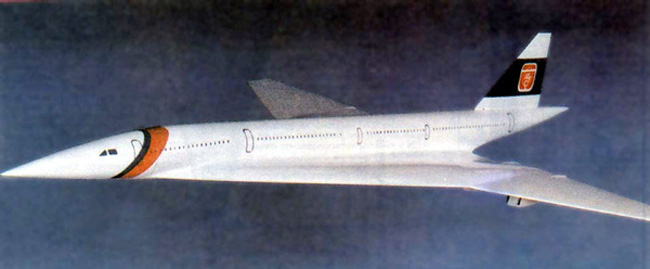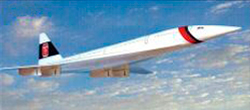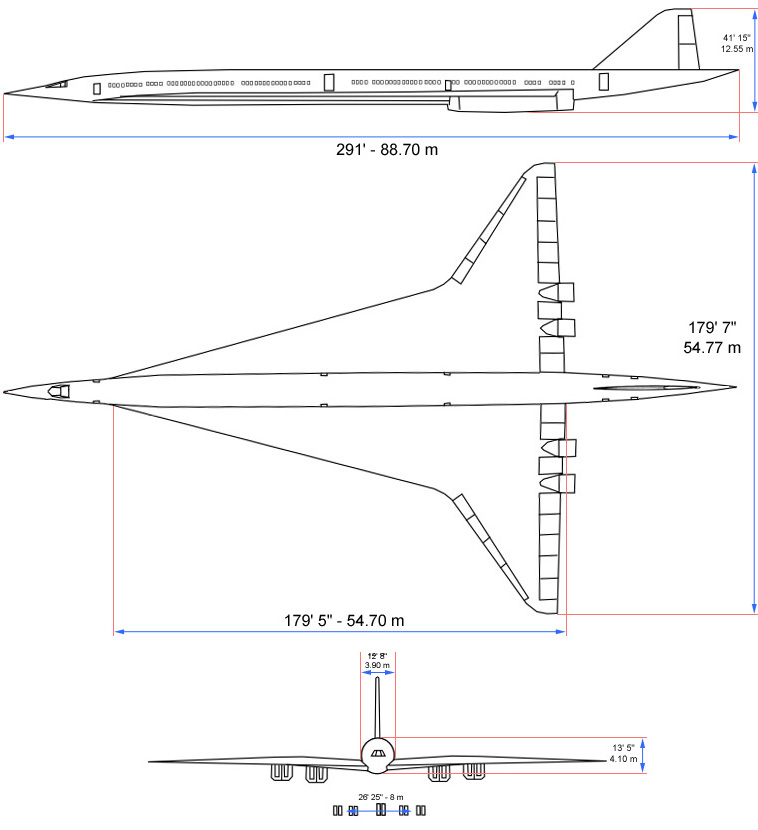







|
It was in the early 70's when the Tupolev OKB (Experimental Design Bureau) began the works for the creation of a supersonic transport of second generation, SST-2. When the first generation of supersonic transport was still not in service, Tupolev decided in 1973 the development of the Tu-244 using as the base the experience acquired for Soviet, European and American in their different SST programs. When the Tu-144 and “Concorde” were designed the main target for both projects was to put a supersonic airliner in the sky. This produced many problems that a SST-2 should solve if she wants to occupy a place between the airliners of the 21st century. The design of the new aircraft should be orientated towards these points:
The collaboration between all the countries involved in the creation of a SST-2 became necessary in the 80's due to the complexity of the project and the quick increase of the costs. The critical economic situation of the Soviet Union delayed this cooperation until 1994 when in the “Group of Eight” was signed an agreement for a joint program that would determine the characteristics of a supersonic transport for the 21st century. As centrepiece of this joint program they were designated initially the two last Tu-144D constructed, units number 08-2 and 09-1. Nevertheless the Tu-244 have been always considerate an evolution of the Tu-144 and using all the experience achieved in the creation of the first supersonic transport is the best way for to obtain a new aircraft capable of to overcome the problems of her predecessor. Finally only one aircraft was modified and designated Tu-144LL Flying Laboratory. |
|
|
During 25 years the program for the development of a SST-2 has generated many proposals. From a plane
of 360 tons, more than 300 passengers and 8,000 km of flight range until the less ambitious, but more
real, of 260 tons, 170 passengers and a range between 7,000 and 10,000 km. Even a proposal with liquid
hydrogen engines was studied.
|

|
The results of the studies showed that a SST-2 should be capable of to compete with big aircraft as B-747, B-777, A340 and A380. This only could happen with a passenger capacity between 250 and 300 persons, but supporting a high aerodynamic quality both at supersonic mode as at subsonic speeds, this would provide a low consumption of fuel that would increase the range of flight and, of course, the economic profitability. We can't forget that all this requisites must be coordinated with a high level of comfort for the passengers and the fulfilment of the strict ecological rules of the 21st century. With all these specifications a model of the Tu-244 was published and is today the most extended idea of how a Tu-244 will be. In the next design and table are described some technical specifications of the project. |


| Prototype Tu-244 | |
| Overall length | 291' - 88.70 m |
| Height from ground (ground to top of fin) | 55' 45" - 16.90 m |
| Height from lowest point (engine) | 41' 15" - 12.55 m |
| Fuselage external width | 12' 8" - 3.90 m |
| Fuselage external height | 13' 5" - 4.10 m |
| Wing span | 179' 7" - 54.77 m |
| Wing length (root chord) | 179' 5" - 54.70 m |
| Wing area | 12,916' 7" ft² - 1,200 m² |
| Main gear track | 26' 25" - 8 m |
| Number of engines | 4 x 33,000 kg |
| Cruise speed | 1,350 mph - 2,175 km/h (M 2.05) |
| Number of passengers | 250 / 320 |
| Range of flight | 5,700 ml - 9,200 km |
| Altitude of flight | 62,000 ft - 19,000 m |
| Max weight without fuel | 379,200 lbs - 172,000 kg |
| Max take-off weight | 771,600 lbs - 350,000 kg |
| Max weight of fuel | 392,425 lbs - 178,000 kg |
|
Unfortunately the Tu-244 is today a forgotten project. Civil area of PJSC «Tupolev»is now focused in the commercialization of the Tu-204 and Tu-214, and the only recent supersonic project was a small business jet designated Tu-444 that has already canceled. Nevertheless all of us know that better times will come and that a passenger supersonic transport of second generation will fly through the sky sooner or later. |


|